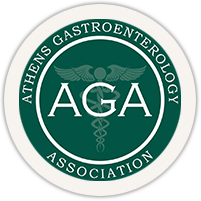Esophageal
GERD: Also known as gastroesophageal reflux disease. Chronic symptom of mucosal damage caused by stomach acid coming up from the stomach into the esophagus. GERD is due to the malfunction of the esophageal sphincter, a valve located at the lower esophagus. The primary symptom is acid reflux, or heartburn, which is felt as a burning sensation in the stomach. Chest pain is also associated with GERD. Your physician may perform an upper endoscopy procedure to insure there are no underlying conditions resulting from reflux. Antacids and proton pump inhibitors (PPI) are usually prescribed along with dietary changes to help treat GERD.
Dyspepsia: Also known as indigestion or heartburn. It’s a condition characterized by chronic or recurrent pain in the upper abdomen. It can be accompanied by bloating, belching, or heartburn. It is frequently caused by reflux or gastritis.
Barrett’s Esophagus: A condition in which the lining at the lower end of the esophagus is damaged by stomach acid. Main cause is thought to be an adaptation to chronic acid expose from reflux disease. Barrett’s esophagus is strongly associated with esophageal cancer. Your physician will perform an upper endoscopy procedure to diagnosis Barrett’s Esophagus. Treatment includes the use of prescription medication called a proton pump inhibitor (PPI) to help minimize reflux symptoms and acid irritation. Patients will also be scheduled for routine endoscopy procedures to monitor the condition.
Dysphagia: Difficulty in swallowing.
Esophageal Stricture: Narrowing or tightening of the esophagus that causes swallowing difficulties.
Hiatal Hernia: Protrusion or herniation of the upper part of the stomach into the thorax through a tear or weakness in the diaphragm.
Eosinophilic Esophagitis: An allergic inflammatory condition of the esophagus that involves eosinophils, a type of white blood cells. Symptoms include swallowing difficulty, food impaction, and heartburn.
Esophageal Varices: Dilated sub-mucosal veins in the lower third of the esophagus. They are the consequence of cirrhosis and have a strong tendency to develop bleeding. An upper endoscopy procedure is performed to diagnosis and treat the varices.
Gastric
Abdominal Pain: Pain in the abdomen area for numerous reasons.
Gastritis: Inflammation in the lining of the stomach.
Helicobacter Pylori: Bacteria which lives only in the lining of the stomach. It is one of the most common infections in humans, and many patients do not have symptoms. H Pylori is related to development of gastritis, dyspepsia, and ulcers in the stomach. It can also be linked to stomach cancer. Your physician will diagnose H Pylori by taking a biopsy during an upper endoscopy procedure. A breath test, blood work, or stool study may also be performed to check for the bacterial infection. H Pylori is treated with antibiotics and PPI therapy.
Ulcers: Also known as stomach ulcers. It is a break in the lining of the stomach, first part of the small intestine, or occasionally the lower esophagus. Symptoms include abdominal pain or burning, melena (dark, tarry stools), and can be associated with reflux. Ulcers are diagnosed through the use of an upper endoscopy procedure. Your physician will prescribe a proton pump inhibitor (PPI) for you to take on a daily basis and may schedule follow up endoscopy procedures.
Gastroparesis: Also called delayed in gastric emptying, is a medical condition consisting of paralysis of the stomach resulting in food remaining in the stomach for abnormally long periods of time. Symptoms include nausea, vomiting, abdominal pain, bloating, or reflux. Gastroparesis is diagnosed through a radiology exam called a Gastric Emptying Study. Your physician will prescribe oral medications and dietary changes to help treat the condition.
Bloating: Abnormal general swelling in the abdominal area. Patient will have symptoms of feeling a full and tightness in the abdomen.
Nausea: Sensation of unease and discomfort in the upper stomach with an involuntary urge to vomit.
Vomiting: Involuntary, forceful expulsion of the contents in ones stomach.
Hematemesis: Also known as vomiting blood. The source is generally the upper gastrointestinal tract.
Melena: Black, tarry stools that is associated with upper gastrointestinal bleeding. The black color is caused by hemoglobin in the blood being altered by digestive chemicals.
Hiatal Hernia: Protrusion or herniation of the upper part of the stomach into the thorax through a tear or weakness in the diaphragm.
Anemia: Also known as “low blood count.” Anemia is a decrease in the amount of red blood cells or hemoglobin in the blood. Patients with anemia may have dark or bloody stools, fatigue, headaches, weakness, dizziness, and more. Your physician may order blood studies, x-rays, colonoscopy, upper endoscopy, or a small bowel capsule endoscopy to help treat and detect where the blood loss is coming from.
Small Bowel (Small Intestine)
Small Bowel Bacterial Overgrowth: A disorder of excessive bacterial growth in the small intestines. Patients typically develop symptoms including nausea, bloating, vomiting, diarrhea, malnutrition, weight loss, and malabsorption.
Celiac Disease: A condition found in individuals with an allergy or sensitivity to gluten. Gluten is a dietary protein found in wheat, barley, and rye. The allergic reaction causes inflammation in the lining of the small intestine. Celiac Disease can be diagnosed through blood work and is usually confirmed with a biopsy taken of the small bowel during an upper endoscopy procedure. Once diagnosed with Celiac Disease, patients are placed on a Gluten Free Diet.
Anemia: Also known as “low blood count.” Anemia is a decrease in the amount of red blood cells or hemoglobin in the blood. Patients with anemia may have dark or bloody stools, fatigue, headaches, weakness, dizziness, and more. Your physician may order blood studies, x-rays, colonoscopy, upper endoscopy, or a small bowel capsule endoscopy to help treat and detect where the blood loss is coming from.
Meckel’s Diverticulum: Is a slight bulge in the small intestine (located in the distal ileum) that is present at birth. It is the most common malformation of the gastrointestinal tract and is present in approximately 2% of the population. Majority of patients with Meckel’s Diverticulum are asymptomatic.
Colon (Large Intestine)
Colorectal Polyps: A polyp or growth occurring on the lining of the colon or rectum. They can vary in size and their cause is unknown. Polyps are detected and removed through the use of a colonoscopy. There are two common types of polyps: hyperplastic, which is not at risk for cancer, and adenoma, which is thought to be a source for colon cancer. Untreated colorectal polyps can develop into colorectal cancer.
Colorectal Cancer: Development of cancer in the colon or rectum. It is due to the abnormal growth of cells that have the ability to invade or spread to other parts of the body. Colorectal cancer is detected through the use of a colonoscopy.
Diverticulosis: Condition in which diverticula are in the colon. They are formations or pouches of the colonic mucosa and submucosa through weakness of muscle layers in the colon wall. They are most common in the sigmoid colon due to increased pressure. Diverticulosis can be diagnosed through the use of a colonoscopy and CT scans.
Diverticulitis: Inflammation of the diverticula in the colon. Patients tend to have left lower quadrant pain and tenderness. Your physician will prescribe antibiotics and sometimes pain meds to help treat this condition.
Rectal Bleeding: Bright red or dark in color blood coming from the rectum.
Guaiac Positive Stool: Presence of blood in the stool. Usually found by patients doing a hemoccult stool test.
Constipation: Infrequent or hard to pass bowel movements. Constipation is a common cause of painful defecation. Everyone’s bowel habits are different and vary from person to person. One can help prevent constipation by drinking plenty of fluids, eating a high fiber diet, taking probiotics, stool softeners or fiber supplements.
Diarrhea: Condition of having at least three loose or liquid bowel movements a day.
Microscopic Colitis: A medical condition that causes chronic, watery diarrhea. Microscopic colitis is diagnosed by taking a biopsy of the colon, and can be subcategorized as Lymphocytic Colitis or Collagenous Colitis. Once diagnosed, your physician will start you on a medication or steroid to help resolve the diarrhea.
Fecal Incontinence: Lack of control over defecation, leading to involuntary loss of bowel contents.
Hemorrhoids: Vascular structures in the anal canal. Internal hemorrhoids usually present with painless rectal bleeding. External hemorrhoids may produce pain, swelling, bleeding, or itching. Even though they are nagging and troublesome, hemorrhoids are rarely serious and often clear up by themselves. Your physician may prescribe you ointments or creams to help with the hemorrhoids. You may also be set up for a banding ligation that is quick, painless, and done in the comfort of the office.
Anal Fissure: A break or tear in the skin around the anal canal. Fissures can be caused by the passage of hard stool or severe diarrhea. Nerve endings and blood vessels are exposed so that pain and bleeding may occur with bowel movements. They usually extend from the anal opening and are usually located posteriorly in the midline. Your doctor may perform a rectal exam to diagnose an anal fissure. Ointments and creams may be prescribe to help alleviate and treat symptoms. Patients may also be referred to a surgeon to have the fissure removed.
Irritable Bowel Syndrome: Is a symptom based diagnosis that is characterized by chronic abdominal pain, bloating, diarrhea, or constipation. It can also be associated with a spastic colon, which occurs when the colon does not contract normally. Stress is a common cause of IBS. Medications are available to help manage IBS.
Crohn’s Disease: Is a type of Inflammatory Bowel Disease that may affect any part of the gastrointestinal tract from mouth to anus; however, the condition usually occurs in the ileum, which is the part of the GI tract where the small and large intestines meet. It is a chronic autoimmune disease, meaning the immune system attacks the body’s own cells. Signs and symptoms include abdominal pain, diarrhea, blood, fever, foul smelling stools, pain when passing stools, and weight loss. Crohn’s Disease is diagnosed through the use of a colonoscopy, small bowel capsule endoscopy, x-rays, and occasional lab work. The disease has no cure, but treatment options are available to help with symptoms, maintain remission, and prevent flare ups. If treatment is not effective, surgery may be required to remove the diseased portion of the intestine.
Ulcerative Colitis: Is a form of Inflammatory Bowel Disease that affects the large intestine. It includes characteristics of ulcers or sores in the colon. Main symptoms include excessive diarrhea mixed with blood, cramping, and abdominal pain. The disease is very similar to Crohn’s Disease, however Ulcerative Colitis only affects the colon. Ulcerative Colitis is diagnosed through the use of a colonoscopy and occasional blood test. Your physician will start you on steroids, anti-inflammatory drugs, or immune suppressant drugs.
Anemia: Also known as “low blood count.” Anemia is a decrease in the amount of red blood cells or hemoglobin in the blood. Patients with anemia may have dark or bloody stools, fatigue, headaches, weakness, dizziness, and more. Your physician may order blood studies, x-rays, colonoscopy, upper endoscopy, or a small bowel capsule endoscopy to help treat and detect where the blood loss is coming from.
Weight Loss: Unintentional weight loss, usually greater than 10 pounds, in a short period of time.
Liver
Hepatomegaly: Enlargement of the liver.
Elevated Liver Enzymes: Evaluation of abnormal blood work.
Jaundice: A yellowish pigmentation of the skin, eyes, and other mucous membranes caused by high blood bilirubin levels.
Hepatitis: Inflammation of the liver. It can be caused by several specific viruses as well as certain medications, autoimmune conditions, and chronic alcohol use. Hepatitis is diagnosed through blood test, abdominal ultrasounds, and a liver biopsy. Hepatitis usually doesn’t require treatment, but will be followed closely by your physician to prevent any damage to the liver.
Autoimmune Hepatitis: Chronic disease caused by an abnormal immune response against liver cells.
Hepatitis B: Infectious disease caused by the Hepatitis B Virus that affects the liver. It can be acute or chronic. The virus is transmitted by exposure to infectious blood or body fluids. One usually develops an acute infection, recovers completely, and develops antibodies that protect them from getting the disease again. The virus can be prevented by vaccination.
Hepatitis C: Infectious disease caused by the Hepatitis C Virus that affects the liver. Patients are usually asymptomatic, but chronic infection can lead to scarring of the liver and cirrhosis. The virus is spread primarily by blood to blood contact associated with needles. Hepatitis C is diagnosed with routine blood test that show elevation in liver enzymes. The physician can then order a specific blood test to determine if you have Hepatitis C. There are treatment options that can be discussed with your physician.
Fatty Liver: Triglycerides, fat cells, accumulate in liver cells. The disease occurs worldwide in those with excessive alcohol intake, obese patients, and diseases that influence fat metabolism. Fatty liver is diagnosed through blood work, ultrasounds, and CT scans.
Cirrhosis of the Liver: A condition in which the liver does not function properly due to long term damage. It is a serious condition that occurs when soft healthy liver tissue is replaced with hard scarring tissue. Cirrhosis is typically caused by alcohol, hepatitis b or c, and fatty liver disease. The disease comes on slowly and patients do not have symptoms early on in the disease. Cirrhosis is diagnosed through CT Scans, MRI scans, ultrasounds, and liver biopsy. Once diagnosed, your physician’s goal is to stop any further liver damage.
Esophageal Varices: Dilated sub-mucosal veins in the lower third of the esophagus. They are the consequence of cirrhosis and have a strong tendency to develop bleeding. An upper endoscopy procedure is performed to diagnosis and treat the varices. Your physician will schedule you for routine endoscopies to manage and monitor the varices.
Ascites: A condition in which excess fluid collects in the abdominal cavity. Ascites is most commonly due to cirrhosis or severe liver disease. Ascites is not a disease, but a symptom of an underlying problem. This condition can be diagnosed by ultrasounds or CT scans. A paracentesis is performed to draw fluid off the abdomen, and your physician may prescribe a diuretic to help decrease fluid buildup.
Liver Cyst or Mass: Cyst or mass that are found inside the liver. They are detected through the use of radiology exams and your physician will monitor them closely.
Hemochromatosis: Accumulation of iron in the body from any cause. Liver is commonly affected by this disorder.
Gallbladder
Cholelithiasis (Gallstones): A calculus or stone is formed within the gallbladder as a concretion of bile components. Symptoms include abdominal pain, nausea, and vomiting. Gallstones are diagnosed by the use of radiology exams (Ultrasounds or CT Scans). Your doctor may refer you out to a surgeon to have your gallbladder removed.
Cholecystitis: Inflammation of the gallbladder.
Gallbladder Dyskinesia: Decrease gallbladder function. Symptoms include abdominal pain, nausea and vomiting, and changes in bowel habits. Gallbladder Dyskinesia is diagnosed with a radiology exam called a HIDA scan. If diagnosed, your physician will refer you to a general surgeon to look at having your gallbladder removed.
Gallbladder Polyp: Growths or lesions in the wall of the gallbladder. Gallbladder polyps are found through the use of radiology exams.
Pancreas
Pancreatitis: Inflammation of the pancreas that can be acute or chronic.
Choledocholithiasis: Presences of gallstones in the common bile duct.
Pancreatic Cancer: Cancer found in the pancreas.

 Discover the services we provide
Discover the services we provide  Learn about the procedures we perform
Learn about the procedures we perform  Request an appointment
Request an appointment  Find patient forms and preparation info
Find patient forms and preparation info  Get information for referring physicians
Get information for referring physicians 


